
In November the lower reservoir had frozen, and it was roaring for days. Sometimes the ice popped loudly; sometimes it moaned and murmured. On this day it was singing, booming and warbling for seconds at a time. I talked to the Farm Manager a few minutes when he came by. I'd been walking the Valley every day for years, and no one thought anything of me being alone and out of sight. After he left, I went out on the pier to be surrounded by the sound of the pond.
I stepped off the pier toward the overgrown willows, and just grabbed one as I fell straight down. It snapped in my hand with the crack of a gunshot; the whole world jerked up hard. "God, you're going to have to get me out of this" I said before I felt the water. It burned. I couldn't touch the bottom.
And then I was lying facedown on the pier, my clothes soaking but my hair dry. I just lay there a bit, and then realized my leather jacket was starting to freeze. So I got up and walked back to my house, encountering no one. At home I took a hot shower, put on my bonepile socks, and crawled under the covers to sleep off the shock. When my husband came home from teaching, I had already mopped up the melt and spread my Leatherman to dry.
At dinner that night the ranch manager's wife sat down across from me and waited. So I told her, as custom demanded. And she didn't say anything, which I took to be a compliment, in that she trusted me to draw the right conclusions on my own. Then over dinner we talked about calving season. The farm manager talked to me, distraught; later, his wife, too. She said, "God sent his angel to get you out."
The next afternoon I dressed in bonepile clothes and helped slaughter Tom Hudgens' flock of red turkeys for their appointment with the new turkey fryer. Parents of a student had taught me to draw birds at his graduation. I had taught some of the new students, 'though not the one who cut the turkeys' throats.
It was an extraordinary meal, and no menu recitation could do it justice. It was baroque and astonishing: dessert rode out with the Valkyries. My husband had to leave for a funeral, so I ate the orgiastic feast with a Mennonite family. During dinner I learned my student wasn't wearing the Leatherman his younger brother gave him, but the one worn by the student who had died. Their mother asked me, "how do you deal with living in a men's college?" Her older son smiled down at his pie, because he knew the answer but had never heard me say it.
*****
Months later, one of our harrowed alumni came straight home to Deep Springs. I met him on the porch of my house with bottles of his favorite beer, and listened to his tale of malaria and dengue fever. He said he lost his Leatherman right after he got there, stranded and broke in Nairobi. When he stopped, I told him:
"Well, I did something really stupid while you were gone. You remember your Public Speaking story about almost drowning in Alaska? While the lower rez was frozen, I decided to take a walk, and fell through the ice. I remember falling, and the cold of the water, but I don't remember getting out. Walking home, I could feel my clothes freezing, my big leather jacket freezing, and I thanked God for everything--for my freezing clothes, for the sand, for how beautiful the sage brush was. There was no fear, no confusion, just gratitude and knowing I had to keep moving."
I took a sip of beer. I hate beer.
"A couple of days later, I saw that the backs of my thighs had a black and blue line of huge bruises, where I struck the ice going down. If I had hit my head rather than my legs, I'd have been unconscious when I went into the water."
He said my name softly, and we finished our Shiners in silence on the swing.
Then we went to the boarding house and scrounged a plate of leftover Moroccan chicken, and I sat with him at the picnic table while he wept in gratitude for the first meat he'd eaten in months.










 Mexican plaque of Our Lady of Tepeyac (Guadalupe). Molded natural plaster, painted. Mexico City, 1980. Both Mary and the angel have blush and eyeshadow, not on the original.
Mexican plaque of Our Lady of Tepeyac (Guadalupe). Molded natural plaster, painted. Mexico City, 1980. Both Mary and the angel have blush and eyeshadow, not on the original.

 Above: Mexican painted terracotta on a kitchen cabinet door. 2007.
Above: Mexican painted terracotta on a kitchen cabinet door. 2007.




 About a decade before coming to Deep Springs, I sometimes spent time with a teaching elder of the Indian Tribe on whose ancestral land my college was built. They had no reservation; the language and especially traditional dance as a form of prayer was how they had maintained their identity. New Agers were not welcome; I was welcome precisely because I was a practicing Catholic and not looking to co-opt their traditions to escape the demands of my own.
About a decade before coming to Deep Springs, I sometimes spent time with a teaching elder of the Indian Tribe on whose ancestral land my college was built. They had no reservation; the language and especially traditional dance as a form of prayer was how they had maintained their identity. New Agers were not welcome; I was welcome precisely because I was a practicing Catholic and not looking to co-opt their traditions to escape the demands of my own.




 These are all over the Siouxland area. The company began in 1871. A 1923 local business profile lists cistern collars, coal chutes, pipes and manhole covers, building columns, and boilers among their products. The large sewer lid shown above is a few feet from a sidewalk engraved 1905.
These are all over the Siouxland area. The company began in 1871. A 1923 local business profile lists cistern collars, coal chutes, pipes and manhole covers, building columns, and boilers among their products. The large sewer lid shown above is a few feet from a sidewalk engraved 1905.



 Two views taken several years ago, with my first digital camera. Some of the tombstones are older than the church; Catholic settlers relocated their family graves from their homesteads when consecrated ground became available. A number of WWI veterans are buried there, and a lot of infants and children from the early days.
Two views taken several years ago, with my first digital camera. Some of the tombstones are older than the church; Catholic settlers relocated their family graves from their homesteads when consecrated ground became available. A number of WWI veterans are buried there, and a lot of infants and children from the early days. This graveyard is adjacent to a tiny Catholic church. Stubble stands in the fields all winter. I had thought that might have been for wind erosion--the wind is terrible--but the combines are set to the precise height needed to give shelter to pheasants.
This graveyard is adjacent to a tiny Catholic church. Stubble stands in the fields all winter. I had thought that might have been for wind erosion--the wind is terrible--but the combines are set to the precise height needed to give shelter to pheasants.